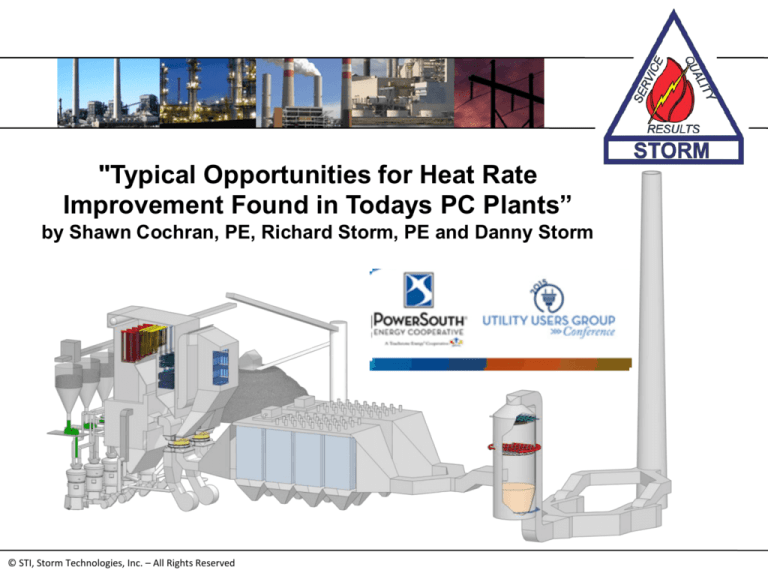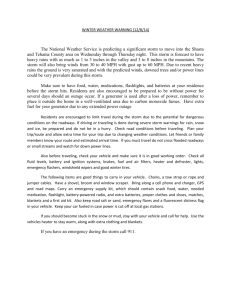
"Typical Opportunities for Heat Rate
Improvement Found in Todays PC Plants”
by Shawn Cochran, PE, Richard Storm, PE and Danny Storm
© STI, Storm Technologies, Inc. – All Rights Reserved
Potential for Heat-Rate Improvement
• The nation’s average heat rate is 10,410 Btu/kWhr
• The top five (20)plants average 9,460 Btu/kWhr
• Although many plants are not designed for a heat rate this
low, most plants still have room to improve their heat rate.
Source: Electric Light & Power; Nov/Dec 2014 - Volume 92/06 – Page 21
Some Individual Losses are:
• Dry Gas Loss
• Loss due to moisture in fuel and air
• Loss due to the combustion of hydrogen
• Loss due to unburned carbon (LOI)
• Loss due to air infiltration
• Assumed losses, radiation and
convection
© STI, Storm Technologies, Inc. – All Rights Reserved
Top 20 Coal Plants Ranked by Heat Rate
Notes:
Most all of these plants are Super-Critical
Source: Electric Light & Power; Nov/Dec 2014 - Volume 92/06 – Page 21
© STI, Storm Technologies, Inc. – All Rights Reserved
Top 20 Coal Ranked Plants by Generation
Notes:
Heat Rate Varies from 9,900–11,000 Btu/KwHr
Noted for Room of Improvement
Source: Electric Light & Power; Nov/Dec 2014 - Volume 92/06 – Page 18
© STI, Storm Technologies, Inc. – All Rights Reserved
General Heat-Rate by Design and Operation
2014
Typical
© STI, Storm Technologies, Inc. – All Rights Reserved
22 Controllable Heat Rate Factors
1.
2.
3.
4.
5.
6.
7.
8.
9.
10.
11.
Flyash LOI (Carbon Content)
Bottom ash carbon content
Boiler and ductwork air in-leakage
More precise primary airflow measurement and
control, by reducing tempering air
Reducing pulverizer air in-leakage on suction mills
Pulverizer throat size and geometry optimization to
reduce coal rejects and compliment operation at
lower primary airflows
Secondary airflow measurement and control for
more precise control of furnace stoichiometry,
especially important for low NOx operation
Reduction of extremely high upper furnace exit
(FEGT) peak temperatures, which contribute to
“Popcorn Ash” carryover to the SCR’s and ApH’s,
High spray water flows, Boiler slagging and fouling,
and high draft losses due to fouling. The high draft
losses cause increased in-leakage, increased fan
auxiliary power wastage and increased associated
losses with the high spray water flows.
High de-superheating spray flow to the superheater
High de-superheating spray flow to the reheater
High air heater leakage (note: Ljungstrom
regenerative airheaters should and can be less than
9% leakage)
© STI, Storm Technologies, Inc. – All Rights Reserved
12.
13.
14.
15.
16.
17.
18.
19.
20.
21.
22.
Airheater Outlet Temperature
Superheater outlet temperature
Reheater outlet temperature
Airheater exit gas temperature, corrected to a “no
leakage” basis, and brought to the optimum level.
Burner “inputs” turning for lowest possible excess
oxygen at the boiler outlet and satisfactory NOx and
LOI. Applying the “Thirteen Essentials”
Boiler exit (economizer exit) gas temperatures
ideally between 650oF to 750°F, with minimal air
in-leakage (no dilution!)
Cycle losses due to valve leak through – i.e. spray
water valves, reheater drains to the condenser,
superheater and re-heater drains and vents, and
especially any low point drains to the condenser or
to the hot well.
“Soot blowing” Optimization – or smart soot
blowing based on excellence in power plant
operation. (Remember, soot blowing medium is a
heat rate cost, whether compressed air or steam)
Feed water heater level controls and steam cycle
attention to detail
Steam purity and the costly impact of turbine
deposits on heat rate and capacity.
Auxiliary power consumption/optimization i.e., fan
clearances, duct leakage, fueling primary air system
optimization, etc…
Stealth Opportunities
Reheat De-Superheating
Spray Water Flows
Air In Leakage
Steam Cycle Losses
High Primary Air Tempering
Airflow
High Carbon In
Ash (LOI)
© STI, Storm Technologies, Inc. – All Rights Reserved
Stealth Heat Rate Loss No. 1: Air In Leakage
© STI, Storm Technologies, Inc. – All Rights Reserved
Tracking Oxygen in the Boiler
Furnace Exit: 2.56%
Location
Leakage
Additional KW’s Required
19.37%
660
Secondary APH 1 Leakage
9.29%
21
Secondary APH 2 Leakage
19.51%
187
Primary APH Leakage
61.11%
432
Furnace Leakage (Avg)
Secondary APH 1 Inlet: 5.73%
Secondary APH 2 Inlet: 5.88%
Primary APH Inlet: 5.42%
Secondary APH 1 Outlet: 7.15%
Secondary APH 2 Outlet: 8.56%
Primary APH Outlet: 11.68%
© STI, Storm Technologies, Inc. – All Rights Reserved
How to Identify Air-In Leakage
• Obtain good reliable, representative flue gas analyses and then calculate
the X-ratio.
• Perform oxygen rise testing from furnace to ID fans.
– A good test grid is required for accurate data collection and leakage calculations
• Monitor the stack CO₂ or O₂.
• Combine the intelligence and conditions found of boiler inspections with
test data, X-ratios and experience.
© STI, Storm Technologies, Inc. – All Rights Reserved
Heat Rate Improvement
• Reduce Secondary Air Heater Leakage
– Reduce 25-30% down to 12-15%
– Rothemuhle leakage rates can be
reduced by 50%
• Reduce the Secondary Air Heater’s
Differential
– Clean APH basket is a must
– High differential exacerbates both APH
leakage & duct in-leakage
– Compounds auxiliary power
consumption loss
• Repair Primary Air Heater Leakage
© STI, Storm Technologies, Inc. – All Rights Reserved
Regenerative Air Heater (Typical Leakage Areas)
AIR Side
Bypass Seal Leakage
passing around the
APH into the cold
gas flow
Bypass Seal Leakage
passing around the
APH into the warm air
flow
Hot Radial Seal Leakage
Cold Radial Seal
Leakage
Bypass Seal
Leakage passing
the axial seals
into the gas flow
Circumferential leakage through an air heater
© STI, Storm Technologies, Inc. – All Rights Reserved
GAS Side
Measuring Air Pre-Heater Performance
• Air In-Leakage calculation:
Leakage (%)
O 2 Out O 2 In
90
20.9 O 2 Out
• Corrected gas outlet temperature:
TGas Out Corrected
%Leakage C p Gas TGas Out TAir In TGas Out
C p Gas
• Heat transfer efficiency:
Heat Transfer Efficiency
• X-Ratio:
© STI, Storm Technologies, Inc. – All Rights Reserved
TGas Out
C p Air TAir Out TAir, In Air Mass Flow
C p Gas TGas In TGas Out Corrected Gas Mass Flow Less Leakag e
Opportunities to Minimize Losses
• There are several ways to minimize heat losses:
• Balance the air and fuel to the burners
• Properly control, proportion, and stage the air
• Minimize air in-leakage
• These items are addressed in Storm’s “13 Essentials
of Optimum Combustion” and “22 Controllable Heat
Rate Variables,” and can effectively improve heat rate.
• Following are real examples of potential and real
performance improvements in several plants that
Storm Technologies has visited
© STI, Storm Technologies, Inc. – All Rights Reserved
Additional Stealth Losses
Steam Cycle Losses:
• High Energy Drains (Valve Leak-by)
• Feed Water Heater emergency drains
• Superheat and Reheat valves and isolation of block valves
• Condenser should be checked regularly. Often 100+ Btu’s
can be attributed to drain leakages
© STI, Storm Technologies, Inc. – All Rights Reserved
© STI, Storm Technologies, Inc. – All Rights Reserved
Typical Opportunities Identified for Improvement
as a Result of Diagnostic Testing
• Air in-leakage prior to the air heater
• Air heater leakage
• A.H. Exit Gas Temperature (corrected for leakage) higher than
design
• High Primary Airflow
• High FEGT and Major Stratifications
• Auxiliary Power is excessive due to high APH differential and air
in-leakage
• Unbalanced furnace requires higher total airflow
• Burner tuning issues
• NOX and/or LOI Improvements
© STI, Storm Technologies, Inc. – All Rights Reserved
Case Study: Imbalanced Pulverizers
The pulverizers in this unit are not
properly balanced. This will result in
an uneven burn in the boiler. Also, the
coal fineness is to coarse based on
our
recommendations,
causing
incomplete combustion. Both of these
circumstances result in poor efficiency
and a less than optimal heat rate.
20.00%
Evergreen Packaging-Canton
Unit 4 Baseline Dirty Air Balance
15.00%
10.00%
5.00%
0.00%
-5.00%
-10.00%
-15.00%
-20.00%
Pipe 1
Pipe 2
A Mill T1
C Mill T1
-5% Recommended
Evergreen Packaging-Canton
Unit 4 Baseline Fineness Results
95.0
20.00%
85.0
15.00%
75.0
10.00%
Pipe 3
Pipe 4
B Mill T1
5% Recommended
Evergreen Packaging-Canton
Unit 4 Baseline Fuel Balance
5.00%
65.0
0.00%
-5.00%
55.0
45.0
-10.00%
50 Mesh
100 Mesh
140 Mesh
200 Mesh
-15.00%
Goal
99.9
95
88
75
-20.00%
A Mill T1
94.8
80.5
68.0
54.5
B Mill T1
92.3
75.7
63.1
50.7
C Mill T1
91.9
76.2
64.4
52.7
© STI, Storm Technologies, Inc. – All Rights Reserved
Pipe 1
Pipe 2
A Mill T1
C Mill T1
-10% Recommended
Pipe 3
Pipe 4
B Mill T1
10% Recommended
Case Study: Imbalanced Pulverizers
This is another case of imbalanced
pulverizers. Balancing the flow through
the pipes and increasing the fineness
of the coal will effectively impact the
overall efficiency of the system and
decrease heat rate.
© STI, Storm Technologies, Inc. – All Rights Reserved
Case Study: Imbalanced Pulverizers
• In both cases, the problem was addressed
the same way.
25.00%
• Changing the setting of the classifier 20.00%
15.00%
blades to improve fineness
Evergreen Packaging-Canton
Unit 4 Fuel Balance, Mill B
Baseline Vs. Post Classifier Adjustments
10.00%
• Balancing the primary air, using clean 5.00%
0.00%
air and dirty air tests for reference.
• The results improved combustion and
increased efficiency.
-5.00%
-10.00%
-15.00%
-20.00%
Pipe 1
B Mill T1
B Mill T2
© STI, Storm Technologies, Inc. – All Rights Reserved
Pipe 2
Pipe 3
10% Recommended
Pipe 4
-10% Recommended
Case Study: Poor Airflow Control
In this case, the primary air to fuel ratio
was excessive. This condition caused the
fuel to “outrun” the secondary air,
resulting in incomplete combustion. The
unit not only had a poor heat rate, but
also had CO spikes.
Setting and
maintaining the proper airflow ratio helped
to resolve this problem.
Before
After
50
15000
50
14000
15000
13000
14000
12000
13000
40
11000
12000
10000
30
8000
7000
6000
5000
20
11000
CO (PPM)
9000
10000
30
9000
8000
7000
6000
20
4000
5000
3000
4000
3000
2000
10
1000
10
2000
1000
0
0
0
0
0
10
20
30
40
Boiler Front
© STI, Storm Technologies, Inc. – All Rights Reserved
50
60
0
10
20
30
Boiler Front
40
50
60
CO (PPM)
40
Case Study: Air In-Leakage
These examples show air in-leakage
after the furnace exit. The ideal
condition of no leakage would leave
the O2 percentage constant. Leaks
in the system cause heat losses and
thus decrease the system efficiency.
10.00
% O2
9.00
8.00
7.00
6.00
5.00
Test 1
4.00
Test 2
3.00
2.00
1.00
0.00
HVT
© STI, Storm Technologies, Inc. – All Rights Reserved
APH In
APH Out
ID Fan Out
Maintaining the System (Performance Preservation)
• The best way to keep a low heat rate
is to monitor and control the known
variables that can cause losses.
• This way, problems can be resolved
before they become big issues.
• These charts show the “as found”
characteristics of one plant Storm has
been regularly servicing for 10 years.
• Consistent maintenance works!
© STI, Storm Technologies, Inc. – All Rights Reserved
Stealth Heat - Rate Factors
© STI, Storm Technologies, Inc. – All Rights Reserved
500 Btu's /kWhr Potential Saving Cost
•
•
•
•
•
Reduction of Air In-Leakage and Dry Gas Loss
Reduction of Air Heater Leakage
Reducing Pulverizer Coal Rejects
Reduced Carbon in Ash
Reduced De-superheating Spray Flows
© STI, Storm Technologies, Inc. – All Rights Reserved
240 Btu/kWhr
60 Btu/kWhr
40 Btu/kWhr
100 Btu/kWhr
60 Btu/kWhr
Thank You
Presented by: Danny Storm
Storm Technologies, Inc.
Albemarle, NC
www.stormeng.com
704-983-2040
© STI, Storm Technologies, Inc. – All Rights Reserved







